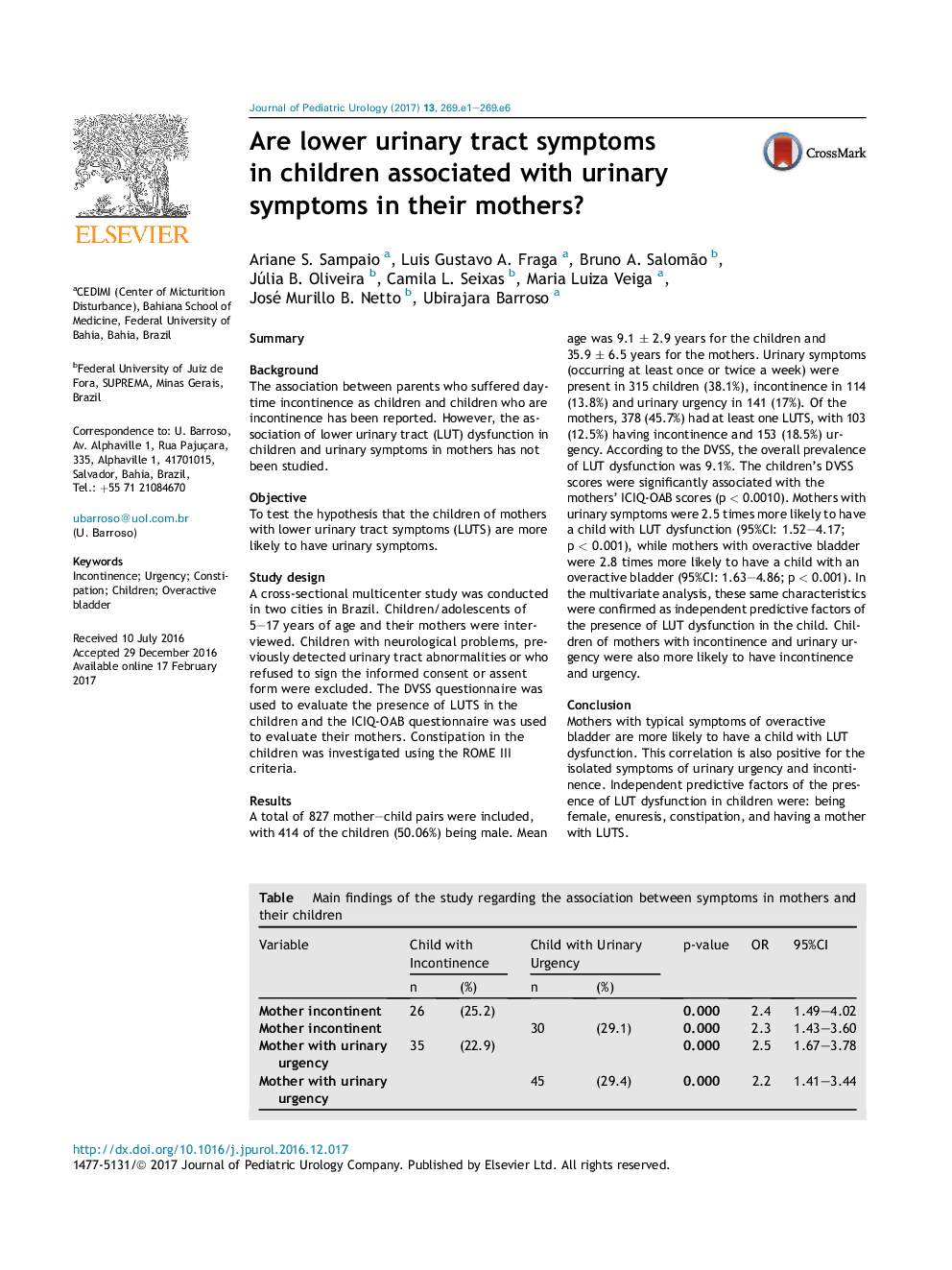| کد مقاله | کد نشریه | سال انتشار | مقاله انگلیسی | نسخه تمام متن |
|---|---|---|---|---|
| 5718587 | 1411254 | 2017 | 6 صفحه PDF | دانلود رایگان |
SummaryBackgroundThe association between parents who suffered daytime incontinence as children and children who are incontinence has been reported. However, the association of lower urinary tract (LUT) dysfunction in children and urinary symptoms in mothers has not been studied.ObjectiveTo test the hypothesis that the children of mothers with lower urinary tract symptoms (LUTS) are more likely to have urinary symptoms.Study designA cross-sectional multicenter study was conducted in two cities in Brazil. Children/adolescents of 5-17 years of age and their mothers were interviewed. Children with neurological problems, previously detected urinary tract abnormalities or who refused to sign the informed consent or assent form were excluded. The DVSS questionnaire was used to evaluate the presence of LUTS in the children and the ICIQ-OAB questionnaire was used to evaluate their mothers. Constipation in the children was investigated using the ROME III criteria.ResultsA total of 827 mother-child pairs were included, with 414 of the children (50.06%) being male. Mean age was 9.1 ± 2.9 years for the children and 35.9 ± 6.5 years for the mothers. Urinary symptoms (occurring at least once or twice a week) were present in 315 children (38.1%), incontinence in 114 (13.8%) and urinary urgency in 141 (17%). Of the mothers, 378 (45.7%) had at least one LUTS, with 103 (12.5%) having incontinence and 153 (18.5%) urgency. According to the DVSS, the overall prevalence of LUT dysfunction was 9.1%. The children's DVSS scores were significantly associated with the mothers' ICIQ-OAB scores (p < 0.0010). Mothers with urinary symptoms were 2.5 times more likely to have a child with LUT dysfunction (95%CI: 1.52-4.17; p < 0.001), while mothers with overactive bladder were 2.8 times more likely to have a child with an overactive bladder (95%CI: 1.63-4.86; p < 0.001). In the multivariate analysis, these same characteristics were confirmed as independent predictive factors of the presence of LUT dysfunction in the child. Children of mothers with incontinence and urinary urgency were also more likely to have incontinence and urgency.ConclusionMothers with typical symptoms of overactive bladder are more likely to have a child with LUT dysfunction. This correlation is also positive for the isolated symptoms of urinary urgency and incontinence. Independent predictive factors of the presence of LUT dysfunction in children were: being female, enuresis, constipation, and having a mother with LUTS.Table. Main findings of the study regarding the association between symptoms in mothers and their childrenVariableChild with IncontinenceChild with Urinary Urgencyp-valueOR95%CIn(%)n(%)Mother incontinent26(25.2)0.0002.41.49-4.02Mother incontinent30(29.1)0.0002.31.43-3.60Mother with urinary urgency35(22.9)0.0002.51.67-3.78Mother with urinary urgency45(29.4)0.0002.21.41-3.44
Journal: Journal of Pediatric Urology - Volume 13, Issue 3, June 2017, Pages 269.e1-269.e6
